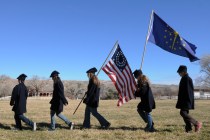Ruins of Fort Pearce make for a historic spot to visit
The ruins of old Fort Pearce in the Warner Valley east of St. George, Utah, still command a view over a spring in a steep-walled canyon. Built in 1866 during turbulent times on the frontier, the little outpost was one of scores established near major travel routes. Manned by Utah militia, the forts provided some protection for settlements, travelers and livestock herdsmen. Just three of the redoubts remain, including Fort Pearce.
To reach this remnant of the real Old West, drive 120 miles from Las Vegas to St. George on Interstate 15. At exit 8, turn south on River Road. Follow it over the Virgin River bridge. Turn left on 1450 South. Drive several miles and turn at the Fort Pearce sign to reach the ruined fort walls. Overall distance from St. George is about 12 miles. The route is only partially paved. Graded side roads may be rough, deeply sandy in spots and slick with gumbo following rains.
The site was selected by Captain John D. L. Pearce of the St. George militia unit in the spring of 1866. It overlooked the only water for miles along an overland route in use before the arrival of the Mormon settlers. In 1776, Fathers Escalante and Dominguez and their party camped at the site on their historic expedition in the Spanish Southwest. When many Mormon couples used it to reach the St. George Temple to marry, it became known as the Honeymoon Trail.
Although built with defense in mind, Fort Pearce never witnessed fighting. Late in 1866, a crew of 20 men arrived at the site. They quarried local sandstone and dry laid walls seven or eight feet high mortared with mud. The main building, a rectangle of 42 by 22 feet, had one door and one small window. The smaller of two rooms had a fireplace. The building never got a roof.
Two opposing corners had "flankers," 4-by-7-foot additions with gun ports that commanded the whole range of fire surrounding the fort. In use for four years, the post had as many as 20 men at a time during 1867. Most of the time just a handful of men stood sentry, ready to send a horseman to warn the nearest settlements when marauders appeared.
Although the Mormons worked at getting along with the American Indian cultures they encountered as they settled in Utah and elsewhere in the West, the clash of cultures and disruption of traditional ways of living inevitably stirred up trouble. In the early 1860s, a raid on cattle by some hungry Utes escalated into a long-term conflict called the Blackhawk War, named for a Ute leader.
For nearly a decade, raids and retaliation for the raids claimed an estimated 70 Mormons, 100 Indians, mostly Utes and Navajos, and thousands of livestock. Many small towns had to be abandoned and resettled later. The toll was heavy in villages such as Grafton near Zion Canyon, where mass graves tell the tale of those who couldn't get out of harm's way soon enough.
Frontier areas across the West faced similar troubles, usually mediated with the arrival of federal troops. The situation in Utah was different because of the antipathy between the Mormons and the federal government over polygamy. The tribes took advantage of the lack of federal policing. Since Mormon petitions for assistance fell on deaf ears for several years, they had to rely on their own militia. Finally, in 1972, the arrival of 200 federal soldiers settled the unrest.
After the militia left, Fort Pearce continued to serve travelers until modern highways linked the little towns of Southern Utah and Northern Arizona. Today, the region draws recreational travelers. Old trails and red sand dunes lure off-roaders with 4-by-4 vehicles, ATVs and motorcycles. Those in high-clearance vehicles explore the 30 miles of sometimes primitive roads linking St. George and Hurricane through scenic back country. Look for a sign marking dinosaur racks found just off the road about three miles beyond the Fort Pearce turnoff.
Fort Pearce Wash just below the old post promises interesting hiking. Birders spot many avian species in this locale, attracted by the availability of water and the variety of trees and vegetation in the canyon. As you explore watch for petroglyphs left behind on boulder by travelers of old, both ancient and native people and soldiers once stationed at the lonely fort.
Margo Bartlett Pesek's column appears on Sundays.






















